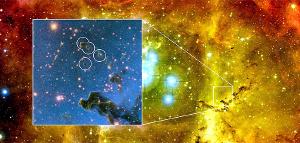Post
Going Rogue
27 August 2013
 ESO/M. Mäkelä
ESO/M. MäkeläA rogue planet is a planet-sized object that doesn’t orbit a star. Instead these objects move through the galaxy just as stars do. They’ve long been thought to exist, but their small size and low temperatures made them difficult to observe.
Then in 2011, a team looked at data from the Optical Gravitational Lensing Experiment (OGLE), which observed 50 million stars in our galaxy looking for momentary brightenings of a star due to an effect known as microlensing. If a massive object passes in front of our line of sight to a star, the light from the star is gravitationally lensed around the object, and this microlensing effect can make the star appear brighter.
The team observed over 400 microlensing events, out of which 10 were due to Jupiter-mass planets not orbiting a star. From these observations, the team estimated that there are likely two rogue planets for every star in the galaxy. That would mean there are 200 to 800 billion rogue planets in our galaxy alone.
Since these rogue objects don’t orbit a star, you might wonder why they would be called “planets” in the first place. After all, asteroids are moon-sized objects that orbit the Sun like planets, and we don’t call them “rogue moons”. The reason they are often referred to as planets is that they are generally thought to have once been planets orbiting a star, but were then ejected from the stellar system due to a close encounter with either another planet in the system or another star. The asteroids, in contrast, formed in orbit around the Sun, and were not once moons around a particular planet, which is why they would not be considered rogue moons.
But new evidence suggests that not all rogue planets begin their lives orbiting a star. In a recent paper in Astronomy and Astrophysics, observations of the Rosette Nebula found dust clouds smaller than the orbit of Neptune, with masses of about 10 Jupiters.1 These can be seen in the image above.
Small clouds such as these, known as globulettes, have been observed before. But these particular globulettes have two properties which make them very interesting. Observations of their radio emissions find that they are unusually dense. This means that despite their small size, they are likely to gravitationally collapse into planet-mass objects. The second is that they are moving exceptionally fast away from the nebular region, about 80,000 kilometers per hour (50,000 mph). At this speed they will escape the gravitational pull of the nebula to become freely roaming objects. This is the first evidence that rogue planets can be born free.
It would seem then that referring to these rogue objects as “planets” might be a bit unfounded. Some have proposed calling them Interstellar Planetary-Mass Objects, while the International Astronomical Union (IAU) has proposed calling them sub-brown dwarfs. But the term “rogue planet” will likely be used for quite a while.
Of course the term rogue planet also raises images of a planet racing through our solar system, either colliding with Earth or sending it into a dangerous orbit. This idea was popularized by the 1951 movie When Worlds Collide, based on the book of the same name. In reality such an event is extraordinarily unlikely. The odds of a dangerous close approach is essentially zero, and even if a rogue planet passed close to our solar system the planets would be hardly affected.
So while some planets go rogue, and others are born rogue, they aren’t anything to be feared.
And none of them are named Nibiru…
Gahm, Gösta F., et al. “Mass and motion of globulettes in the Rosette Nebula.” Astronomy & Astrophysics 555 (2013): A57. ↩︎